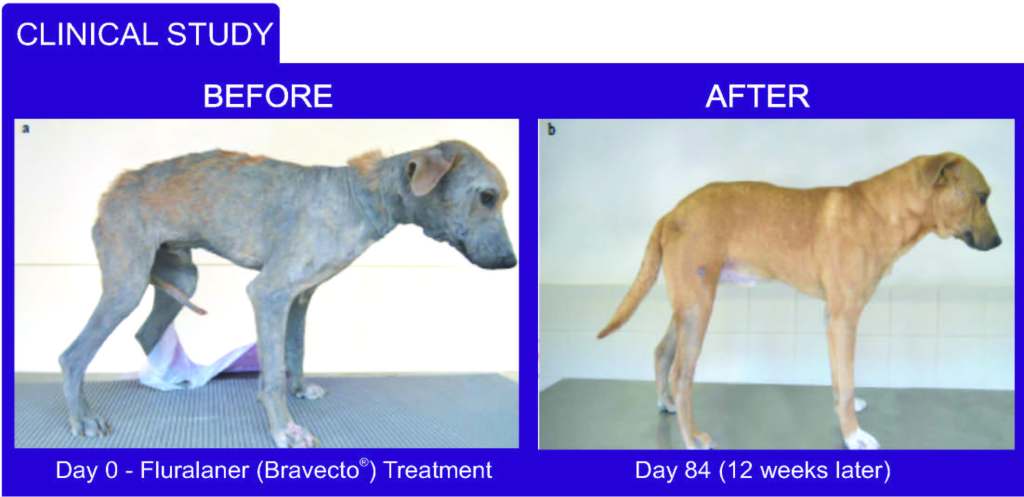

WHAT ARE
MITES?
Mites are microscopic organisms that occur naturally on dogs, but, certain conditions may cause the natural mite number to increase resulting in mange to occur. There are 2 common types of mites that can cause mange:
- Demodex canis
- Sarcoptes scabiei
1. DEMODECTIC MANGE1

Canine demodicosis (demodectic mange) is a common inflammatory parasitic skin disease believed to be associated with a genetic or immunologic disorder (usually involves some form of immunosuppression which can have a number of causes). This disease allows Demodex mites from the normal skin flora to proliferate in the hair follicles and sebaceous glands, leading to:
- hair loss
- redness
- scaling
- secondary bacterial and/or fungal infections
The face and forelegs to the entire body surface of the dog may be affected.
Juvenile-Onset: Demodicosis may occur in dogs 18 months of age or younger as a result of an immunocompromised state associated with:
- internal parasite infestation,
- malnutrition or
- health debilitation
Puppies may also develop demodicosis due to an immature immune system or mite-specific immunoincompetency.
Adult-Onset: In dogs > 18 months of age, demodicosis may occur as a result of immunosuppression due to drugs or systemic disease. Evidence has indicated that successful treatment of an underlying disease, when identified, may contribute significantly to remission of demodicosis. However, up to 56 % of dogs with adult-onset canine demodicosis have been reported to have no detectable underlying disease.
In a clinical trial with Bravecto®, there was 100 % efficacy against Demodex after only 1 Chew2

2. SARCOPTIC MANGE 3

External parasites are a common cause of skin diseases in dogs. Among these, an infestation with sarcoptic mange (Sarcoptes scabiei) is one of the most frequent mite infestations worldwide. This is a burrowing mite, infesting not only dogs, but also cats, pigs, rabbits, sheep and humans.
The mites prefer less hairy regions of the host’s body. Sarcoptic mange is highly contagious and highly pruritic (itchy), making it one of the most uncomfortable skin diseases of the dog. Infestations are non-seasonal and occur by direct contact with an infested dog or by contact with infested dog’s bedding.
The clinical signs include:
- intense constant itchiness
- reddened skin and rash
- papules and yellowish crusts that form on the skin surface
- together with hair loss
The most affected skin areas are:
- around the eyes
- ears
- elbows and
- hocks
With spread to other areas over time.
Definitive diagnosis relies on the microscopic demonstration of mites and their eggs on skin scrapings which can be very difficult due to their burrowing nature.
3. EAR MITES 4
Ear mites (Otodectes cynotis) are a common mite infestation of dogs and particularly cats, found worldwide. Puppies appear to be more susceptible. Mites live on the surface of the ear canal. The resultant dry, dark debris is said to look like coffee grounds.
Clinical signs may include itchiness and head-shaking, but infestations can be subclinical. In heavy infestations mites may leave the ear canal, causing infestations of the head, neck, and tail head. Ear mites are readily transferred between hosts during close contact, and infestations are prevalent in animal shelters and breeding establishments.
Diagnosis: clinical signs will usually prompt an ear examination, and diagnosis is made by observation of mites in swabs of the ear canal. The life cycle is around 21 days, and treatment should be effective (or continued) beyond this time frame so that larvae hatching from incubating eggs can be killed.
If you suspect your pet has mites, visit your vet to confirm and assist in treatment options
For the treatment of Demodicosis caused by Demodex spp. and Sarcoptic mange mites. As well as for the treatment of Otodectes spp. (ear mite) infestations.
Bravecto® has changed the lives of many dogs with severe mange



References:1. Dr Sandra N. Koch (DVM, MS, DACVD, University of Minnesota) Updates on the Management of Canine Demodicosis, TVPJOURNAL.COM, JANUARY/FEBRUARY 2017 issue, p77-85. 2. Fourie J, Liebenberg J, Horak I, Taenzler J, Heckeroth A, Frénais R. Efficacy of orally administered fluralaner (BravectoTM) or topically applied imidacloprid/moxidectin (Advocate®) against generalized demodicosis in dogs. Parasites & Vectors20158:18 3.Taenzler et al. Efficacy of fluralaner administered either orally or topically for the treatment of naturally acquired Sarcoptes scabiei var. canis infestation in dogs. Parasites & Vectors (2016) 9:392 4. Dr Hannah Field (BVSc, MSD Animal Health), Dr Hugh Hasselman (BVSc, VetSouth Gore). Bravecto® Case Study: Efficacy against ear-mites in 16 hound puppies 5. Bravecto’s efficacy against Otodectes: Taenzler et al. Efficacy of fluralaner against Otodectes cynotis infestations in dogs and cats. Parasites & Vectors (2017) 10:30

